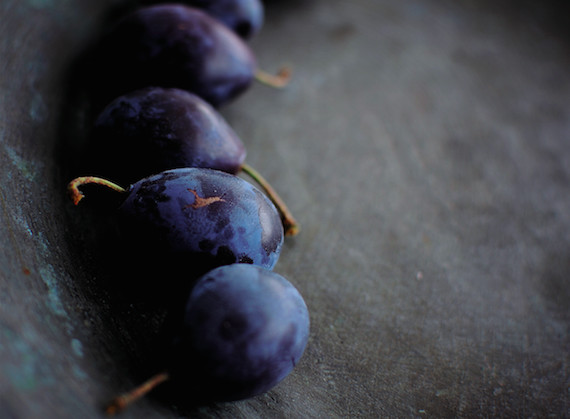
Damsons are right in season. Anistatia Miller and Jared Brown show how to employ the plum sub-species in liquid and solid form
This was the first summer we’ve been off the road and in the garden every day. A wondrous and ponderous epiphany transpired while weeding, feeding, and harvesting: our glut of fruit, veg, and botanicals need to be used for more than drink. Back when we teamed up with Sasha Petraske to design the menu for the Double Seven in Manhattan, we dwelled on drink meets amuse – a nibble that complemented each tipple. This mindset reduces waste and expands your opportunities to buy and exploit bulk from your food supplier. (Our cohort in New York, Ryan, had that dilemma when he ordered all his lockdown foods from an Asian restaurant supplier. It challenges you to use every single morsel that comes through your door and find ways to improve its shelf-life.)
The first fruit to challenge us this month is the frequently overlooked damson, the less-celebrated cousin of the sloe. Damsons and sloes tend to get lumped together, but these two hedgerow members of the plum family differ like night and day. Damsons are larger and tend to ripen in the late summer and early autumn. Their flavour profile differs from the classic dark cherry, citrus, cinnamon and marzipan of sloe. Damsons are richer and sweeter with remarkable dark chocolate notes, which makes them more like domestic plums.
There’s more to make than damson gin and damson vodka – not that there’s anything wrong with those, but you can get quicker gratification from damsons than waiting months for the classic maceration: pick a few handfuls (enough to fill a 1-litre Kilner jar about a third to halfway); freeze them for a couple days then put them in the jar; fill with spirit; steep for three months; sweeten to taste.
We have damson Irish whiskey – a house favourite – going at the moment. We have damson brandy. We’re steeping a damson rum with a silver Cuban rum. No sweetener required with these two. They’re punchy and slightly bitter without the sugar, which makes them wildly good for making more grown-up drinks. Just 25ml of one of these unsweetened damson wonders, taken straight from the fridge into a champagne glass and topped with bubbly, offers an epiphany in unsweetened fruitiness.
Damsons are beautiful with cacao nibs. Infuse 250-300g of frozen damsons for a month in gin or cognac, then add 50g cacao nibs and let it rest for about a week. Sweeten if you want, but you’ll get more mileage by sweetening the drink, not the liquid.
Adding to the Infusion
You can take damsons in an entirely different direction by adding autumn raspberries to the infusion. The raspberries add brightness and accentuate the damsons’ citrus notes. About 250g of each should do the trick. Let it steep for two or three weeks. Done.
Cheese is the perfect accompaniment with the flavours and aromas of damson-infused spirits. What really rocks this amuse bouche is a damson take on classic quince cheese, or membrillo. Damson cheese won’t take up precious kitchen space and it has a shelf-life of about one year in the fridge or freezer.
Start by putting two small saucers in the freezer. Really. Next, put 2 kilos of washed damsons in a large preserving pan or kettle. Add 300ml water and 1tsp of ground allspice. Bring to a boil. Simmer gently for 20-25 minutes until the fruit becomes pulpy. Remove from heat and cool a little. Press the fruit through a China cap or sieve into a bowl or jug. Measure the resulting pulp. For every 600ml of pulp, add 450g of caster sugar. Add 25g butter. Bring the mixture to a boil, stirring to dissolve the sugar. Boil steadily for about 10-20 minutes. Take one of the saucers out of the freezer and spoon a little of the mixture on to the surface. Wait a minute, then push with your finger. If it wrinkles a little, it’s done. If not, keep boiling and try again. When done, spoon the mixture into a parchment-lined backing dish and cool overnight. Next day, cut into squares and wrap each in cling film.
For service, you can slice a piece of damson cheese and serve with manchego or a soft goat cheese. You can also cut small cubes of this fruit cheese for a garnish on ice cream or other pudding. You can even take those cubes and garnish one of your damson-infused spirit creations to give your drink an extra boost of seriously rich fruit.
If you’ve had the same luck that we had in harvesting about 4 kilos of damsons, or got a really great deal from your local market or supplier, these recipes should get your creative juices flowing. Enjoy.


